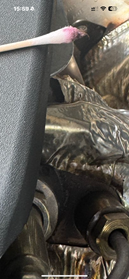Chromium (VI) (chromate) under the hood
- Markus Sommer

- Sep 30, 2024
- 3 min read
The fact that chromates are formed when (earth) alkaline high-temperature materials are used on stainless steel hot parts is no longer denied, even if there are constant attempts to design the warning messages in such a way that the impression is created that nothing can be done or that the risk is extremely low.
What is new, however, is that cars are also affected; our team was able to detect chromates in the exhaust aftertreatment system of two different vehicles:
Picture series above: Mercedes Benz W123
Picture series below: Audi A6 V6
The result is not surprising, because the same insulating materials as in industry are used in the engine area of motor vehicles, particularly in the exhaust gas aftertreatment area, but also in turbochargers and other hot parts, and these contain calcium and/or sodium oxides in sufficient form to react thermochemically and produce the carcinogenic and chronically environmentally harmful chromates, i.e. hexavalent chromium compounds.
As early as December 2023, the company MAN Truck & Buses SE warned of the formation of chromate in large engines:
It can therefore be assumed that heavy commercial vehicles (trucks) and construction machinery are also affected, because insulation materials containing (alkaline earth) metal oxides are found everywhere in the engine area.
Savings in manufacturing technology for metallic engine insulation further increase the formation of chromium (VI)
In the case of so-called metallic integral insulation, the hot parts were initially wrapped with an insulating material and then sealed all around with a metal foil, which prevented the formation of carcinogenic chromates because neither moisture nor oxygen could affect the insulating materials.
Nowadays, the metal elements are only partially welded or clipped on.
These savings in manufacturing technology result in the insulating materials absorbing moisture, which leads to the formation of calcium hydroxide, particularly in insulating materials containing calcium.

Although calcium is an alkaline earth metal (alkaline earth), calcium hydroxide is basic and basic elements are capable of attacking the passive layer of stainless steel.
Chromium (III) oxides, which are important components of the stainless steel alloy, are released by the action of basic solutions on the passive layer and then react thermochemically with the (alkaline earth) oxides contained in the insulation materials, mainly calcium oxide or sodium oxide, and then form, in an oxygen environment, the carcinogenic and chronically environmentally harmful chromates calcium and/or sodium chromate.
Danger to vehicle occupants, service companies and the environment
Chromates are extremely fine particles and are classified as carcinogenic worldwide. As CMR substances, there are no tolerance values in the workplace, but rather so-called exposure risk assessments. Even with one microgram of chromium (VI) compounds per cubic meter of ambient air, the risk of developing cancer is still 4:1000, i.e. four cases of cancer are expected out of 1,000 people exposed to chromium (VI) compounds.
Since chromium (VI) compounds are also considered to be air-resorptive, mechanics and service staff in particular are also exposed to a high risk. The fine particles can settle anywhere in the engine compartment, so if all regulations are correctly interpreted, repair or service work should only be carried out in full protective work clothing.
There is also a great danger for the environment. Chromates, which are classified as chronically harmful to the environment with long-term effects on aquatic organisms (H410), must under no circumstances be allowed to enter groundwater or wastewater.
While it is still possible to react specifically to hazards in a workshop, it is impossible to prevent dangerous substances from being released into the environment during driving.
Once again, the magnitude of the chromate disaster is evident, because compared to asbestos fibers, chromates are classified as harmful in significantly more categories. Both asbestos and chromium (VI) compounds share the classification "H350 - may cause cancer." However, unlike chromium (VI) compounds, asbestos fibers are not considered to be chronically harmful to the environment.
If asbestos fibers were discovered in the engine compartment, it would certainly be a scandal for the automotive industry. But if substances classified as significantly more harmful, such as chromates, are found, things remain suspiciously quiet (for now).


















Comments